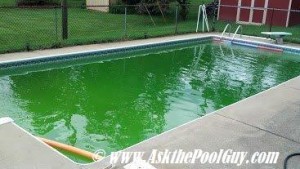
Cleaning and Preventing Algae Blooms

When caring for a swimming pool, you can actually expect not to have to spend too much time per week treating it. But, on occasion, life will get in between you and your pool, and left dealing with algae growth in your swimming pool. Just by being able to identify which type of algae is growing in your pool can dramatically shift your ability to treat it, and extinguish it from its localized existence.
It is important to note that there are three particular breeds of algae that form and bloom in the common pool. You may have come across either green algae, mustard algae, or black algae.
Green algae – Most likely, you have had to face a little bit of green algae before. Green algae blooms create a green glow in the water around it. This type of algae will often float on the surface of the swimming pool, or will rest on the walls, steps, and floor of the pool and actually changing the color of the pool.
Green algae blooms are best combated by brushing your pool, maintaining a chlorine level between 1 and 3 ppm, keeping the pH of your pool near the ideal level of 7.5, and then adding shock to your pool. After these steps are taken, it is suggested to run your filter for a day straight. Clean your filter afterwards to remove any algae from an origin. Now, brush the pool, and continually run the filter and an automatic cleaner until the pool appears clear. Repeat with more chlorine if necessary.
Mustard Algae – Can be an absolute pain to deal with if you don’t know exactly what you are doing. Most of the common store bought chlorines and chemicals will not exterminate this species from the pool. Often times, pool owners will think that they have exterminated the algae’s presence from the pool, but one of the main staples of mustard algae is that if the pool chemicals do not kill even the most microscopic particles of the algae, they will multiply when no one is looking and come back to terrorize again.
To properly combat mustard algae, either specific mustard algae chemicals must be purchased, or you have to drain your swimming pool and scrub away any existing algae remnants. Draining your pool is usually much more effective than waiting for the chemicals to go to work. The possibility of the spores surviving to come back and wreak havoc again and again can be time consuming, and dreadful. But, if you’re the environmentally friendly type, that may be a lot water sent through the drain. If you suspect mustard algae, a pool cleaning professional, may very well be the best idea to be certain you won’t be seeing these unfriendly guests anytime soon. Otherwise, look into the best rated mustard algae specific cleaner you can get from your local pool store, or online.
Black algae normally will appear as dark spots with a greenish-blue hue with a diameter comparable to that of pushpin, to that of a large coin. This kind of algae sticks to the walls of swimming pools and is much harder to scrub away than green algae. Black algae is often introduced to pools from oceans. If someone swims in the ocean, then enters the pool without washing their bathing suit, they could potentially bring about a black algae bloom. Black algae have roots that grow into the sides of walls seeping into concrete slabs plaster. Because of their growth being in shady spots of the pool and their dark complexion, when noticed, they often require forceful scrubbing and stronger chemicals than your normal green algae cleaners to send it away. To send black algae blooms to their grave, start with using three times the shock you would normally use. Then, get to scrubbing. Add the normal amount of shock each day following while continuously using forceful scrubbing techniques to work away at the infectors.
Prevention – Quick reaction is the most important step you can take when noticing any sign of algae growth in your pool. Nipping the problem in the bud as early as possible is certainly key for keeping as much money in your pocket when dealing with pool problems. Important factors for preventing future algae growth include:
- Maintaining an ideal pH balance of 7.5
- Keeping chlorine between 1.0ppm and 3.0ppm
- Running your pool filter for an 8-hour timespan every 24 hour period with an automatic pool cleaner
- Maintain daily brushing to prevent any collective algae growth
- Shock your pool a couple times per month
- Keep any additional pool equipment clean
We hope with these tips in your back pocket, you’re going to be able to spend less time cleaning, and more time enjoying your pool following an algae outbreak. If there’s a question you have regarding this post, just Ask the Pool Guy!
About the Author – Alec Stevens
This guest blogger owns and operates a pool cleaning and repair service in the California East Bay Area.
